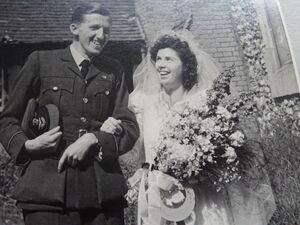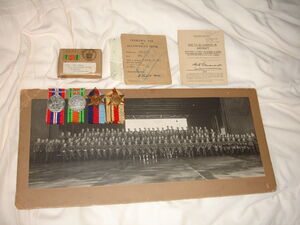Biography
Charles Stewart Hare was born by Caesarian section at the Royal Infirmary, Kingston-upon-Hull, Yorkshire, on 10th May 1919.
At the time, his mother and father, Annie and Albert Hare, were living in one of the Brick Kiln Cottages in Patrington in the East Riding of Yorkshire, where his father ran the brick and tile works. When they moved to Thirsk in the North Riding, again to run the brickworks (near Thirsk Junction), Stewart attended primary school at Carlton Miniott. To get there and back entailed crossing the main London to Edinburgh railway line on foot.
After Annie was widowed he and his mother returned to her home town of Grimsby, in Lincolnshire, where they lived at 61 Alexandra Road. Charles Stewart - "Charlie", as he was known there - attended Wintringham G.S. Before 3rd September 1939, when Britain declared War on Germany, he had volunteered to join the RAFVR.
On the outbreak of War, 46 Squadron - a Hawker Hurricane squadron - was stationed at RAF Digby, in Lincolnshire. Later they were posted to Bardufoss in Norway, and were there at the time of the German invasion. For their return in June 1940, they succeeded in getting the aeroplanes down on an aircraft carrier, despite this not having arrestor wires: a "first", it is believed, for planes other than biplanes such as the Swordfish. All but two of the pilots were lost when HMS Glorious and two warships in her convoy were sunk in the North Sea by Scharnhorst. Stewart was on another ship (his mother explained): HMS Devonshire, which brought King Haakon VII of Norway from Tromsø to safety in Britain ... which is why a Christmas Tree is sent every year in gratitude from Oslo to Trafalgar Square in London.
Stewart met Miriam during the Battle of Britain, when (after the disastrous Norwegian campaign) 46 Squadron from Lincolnshire re-grouped at Stapleford Tawney, a satellite of RAF North Weald, in Essex. Once the Battle of Britain had been won, the British public wanted to know how it had been achieved. Churchill of course wrote, "Their Finest Hour". But how did it work operationally ? people wanted to know. It is perhaps less well known that it was decided to publish, the following year, a description of life in the Operations Room of a fighter squadron; and 46 Squadron - which flew Hurricanes - was chosen as a public example: https://www.amazon.co.uk/READINESS-AT-DAWN.../dp/B000FMMKTM refers (and CSH again, from Alexandra Road, Grimsby, appears on the dust-jacket). A little more information about the Squadron in WW2 may be found at the web page, http://www.alanhare.me.uk/History/46Squadron/46Squadron.html . (Alan Hare, Stewart and Miriam's son, apologises for the poor quality there of the photographs of photographs: were he able to repeat the process today, he feels sure he should get a better product; but in the meantime he has passed Stewart's original WW2 scrapbook to the Squadron Association, so is unable to repeat it.)
Stewart's wartime notes could be of interest historically. When he was grounded he retrained in intelligence, and during his training made copious notes as an aid to his learning. Some of these concerned the early use of so-called "truth drugs": psychoactive substances intended to cause the subject to reveal factual information when being interrogated ... there were not one, but several. What you should try in different circumstances was described; but also what not to use, and why not. Such approaches were made on both sides, and the notes made mention of what was known about their use on prisoners in Germany. There was also a mysterious reference to the fact that, in a particular German camp, "Japanese methods (were) employed" (they shared ideas, we think) ... though without stating explicitly what these methods were: they may have been known or unknown.
At the time that Alan passed Stewart's WW2 scrapbook on to the 46 Squadron Association, a few years back, they had three scrapbooks but - perhaps surprisingly - nothing from WW2. But Alan thinks that other wartime material has come their way since. The Squadron's own website is https://www.smr46.co.uk/46sqn/, which has numerous links at https://www.smr46.co.uk/46sqn/index_files/Page4916.htm .
It could be that few photographs were meant to be taken. At Gambut in the Western Desert, in 1943, Stewart (by then Pilot Officer) was given express permission to use the camera - typewritten permission - by the brave Wing Commander G A Reid (see below): we emphasise, "the camera" (at the time, there may not have been that many available). Astonishingly, at Alan and Sally's engagement party over 40 years later, Alan's prospective father-in-law recognised Stewart from 1943 ! "You're the chap who rode around the desert on a motorcycle!", Roy Gaisford exclaimed ... he was in a different Squadron, but on the same Wing. What are the chances of that ?
By the time of Victory in Europe on 8th May 1945, Charles Stewart Hare had been promoted Flying Officer with 603 Squadron.
Stewart and Miriam married on 16th June 1945, at Theydon Garnon, near Epping, Essex. Best Man was Harry Pickering of Grimsby (and later of Bicker, near Boston), Lincolnshire.
Stewart hardly spoke about the War. News of such losses was considered bad for morale, so it must never be broadcast; and "never" was a long time. Also it was painful to recall the loss of friends now absent. The RAF had been "his university", he said. His son Alan Stewart Hare kept his 46 Squadron photo at RAF Digby, before they all went to Norway. It was only over 50 years later, when Alan and his wife Sally mentioned their plans for a holiday on the Greek island of Kos, that Stewart recounted an instance when Wing-Commander G A Reid - "the bravest Man [he] ever knew", he said - flew to his death over Kos; and did so knowingly [in the light of intelligence], we understand, leading the Squadron personally; of whom not one pilot returned. For the second time in the War, Stewart had lost all his pals. "So", he concluded (to his son), "if you think you're the subject of poor management decisions, lad ... think on that." "Those brave boys", he muttered, years later when he saw another supermarket trolley in the river. Sally and Alan didn't go to Kos.
Stewart would never himself have made such a thing public ... but, after some heart-searching, Alan felt that it had to be told, in fairness to the memory of those who sacrificed their lives.
After demobilisation in 1946, Stewart returned to the Great Grimsby Gas Company. This was a major employer in the area, with head office in Sheepfold Street and Gas Showrooms off Bethlehem Street. From their Pension and Life Assurance Scheme in 1945, it seems that the Company had sized up what it could offer the employee who would join or return after WW2. Stewart, who had joined as a school-leaver in the era of Colonel and Lady Kennington, was there from 1935 for more than 25 years, with a break for War service. The industry underwent major changes:
- before and after WW2: many "coppers" (hot water boilers), which previously had been directly coal-fired, became gas-fired. A back boiler would last 40 years or more.
- before and after Nationalisation: many products came from "coal-cracking" (dry distillation), including domestic coal gas and coal tar soap; the coal for Grimsby came by rail from Rossington, on the Yorks., Notts. and Derbys. coalfield. (In the days when Grimsby had a gas works, "Gas Alley" was called Gas Works Passage.) A farmer on the outskirts of Waltham tried to make ammonium fertiliser from the surplus ammoniacal liquor (a by-product).
- before and after North Sea Gas: afterwards, all gas cookers had to be converted or replaced. (Miriam negotiated a new one free of charge, on the grounds that the conversion hadn't been her decision!). Later, the "gas man" had to train as a CORGI-registered engineer.
What next ? Who knows.
For Stewart, it was to study Mathematics and Statistics, and to retrain in Huddersfield as a teacher. This equipped him, after a period of teaching experience with Havelock in Grimsby, to help set up a Business Studies department at a College of Further Education in the south-west of England. He retired from there 20 years later as Principal Lecturer in 1983, at the age of 64.
Charles Stewart Hare passed away in January 2003. [1]
Sources
- ↑ Personal recollection of events witnessed by Alan Hare as remembered before, on and after 1st January 2024.
Memories: 1
No known carriers of Stewart's DNA have taken a DNA test.
Have you taken a DNA test? If so, login to add it. If not, see our friends at Ancestry DNA.
Featured Female Poet connections: Stewart is 20 degrees from Anne Bradstreet, 22 degrees from Ruth Niland, 32 degrees from Karin Boye, 31 degrees from 照 松平, 25 degrees from Anne Barnard, 42 degrees from Lola Rodríguez de Tió, 29 degrees from Christina Rossetti, 23 degrees from Emily Dickinson, 36 degrees from Nikki Giovanni, 27 degrees from Isabella Crawford, 23 degrees from Mary Gilmore and 22 degrees from Elizabeth MacDonald on our single family tree. Login to find your connection.





